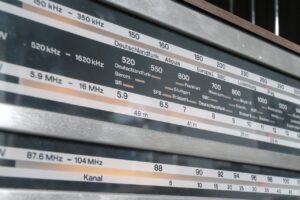
Glenn with his wrist-mounted altazimuth DX-398 for MW direction-finding.
By Jock Elliott, KB2GOM
Since he was in grade school, Glenn Hauser has had the itch to receive broadcasts at long distance, and that interest, continuing throughout his lifetime, has led him to become one of the most respected authorities in the world of radio.
SWLing: How did you get started in radio?
GH: I started with TV DXing, trying to pick up Albuquerque 100 miles away, but often getting sporadic E skip stations more than 1,000 miles away. I also started tuning around medium wave. I was 8 or 9 years old.
SWLing: How did you get started with shortwave radio?
GH: In 1954, the family moved to Oklahoma City. By 1957, I acquired a Hallicrafters S-38E and was listening to shortwave using a longwire antenna, sending off for QSL cards. I was still doing TV DXing.
Then in 1961 the family moved to Enid, better for TV DXing, away from all those local stations, also radio DX. I acquired a Hammerlund HQ160, which was quite an improvement.
SWLing: Were you professionally involved in radio?
GH: In college, I worked on the campus radio station and also at a classical music station, KHFM. My BA was in broadcast journalism. After college, I continued to work on classical musical stations as programmer and announcer. I was very interested in foreign languages, learned phonetic schemes of various languages and learned to pronounce them. Radio Budapest was particularly helpful with Hungarian, which some announcers find difficult. I spent my professional career working for classical music stations.
I spent a year in Thailand, working for the American Forces Thailand Network. I was a newsman on the air in 1969 and 1970.
I had the HQ160 and a small TV in a footlocker, and in my spare time, DXed TV from as far as South Korea and the Philippines and medium wave from Europe.
After four years in the USAF, I resumed classic music radio, notably at WUOT, Knoxville.
By then I was contributing to various DX programs on SW stations, clubs, and eventually started my own program World of Radio. You can find out when to hear my program on the Schedules page at www.worldofradio.com . One of the main places to hear it is on WRMI in Florida. I was SW columnist for Popular Electronics, and later, Monitoring Times. Also published my own magazines, Review of International Broadcasting, and DX Listening Digest; at first on paper, then online.
SWLing: How did you get involved in logging SW radio stations?
GH: It was a natural outgrowth of enthusiasm for hobby; I was a regular contributor to DX Jukebox on Radio Netherlands (monthly) and Radio Canada International’s DX/SWL Digest (weekly).
SWLing: What sort of equipment do you use?
GH: A JRC NRD 545 and an Icom R75 for shortwave and medium wave. For antennas, I use a Wellbrook loop, a 100-foot random wire oriented east-west outside, and some shorter random wires inside the house. It is noisy where I live, and I’ve been trying to get the local electric company to fix line noise radiation.
Here in the town, my property is limited in space for antennas. I’ve been known to hook on to a wire fence in the country as a de facto Beverage antenna.
SWLing: How many hours a day do you monitor?
GH: It varies. Because of my program and my logging reports, I have made myself a nexus for information, so a lot gets sent to me. As a routine, I am always tuning around at bedtime, as well as various times during the day. At random times, I may do a band scan to see what’s happening.
SWLing: What are you most memorable moments listening to SW?
GH: Certainly one was October 4, 1957, hearing Sputnik on 20 megahertz.
SWLing: Any tips, tricks or advice you would care to offer to SWLs or DXers?
GH: Become as well informed as possible by participating in groups such as https://groups.io/g/WOR . Be aware of various references online such as the big 3 SW frequency listings, Aoki, EiBi, and HFCC, among those linked from my homepage http://www.worldofradio.com . In addition, scan the radio bands until you are familiar with what’s there, so you can notice something new or different.








